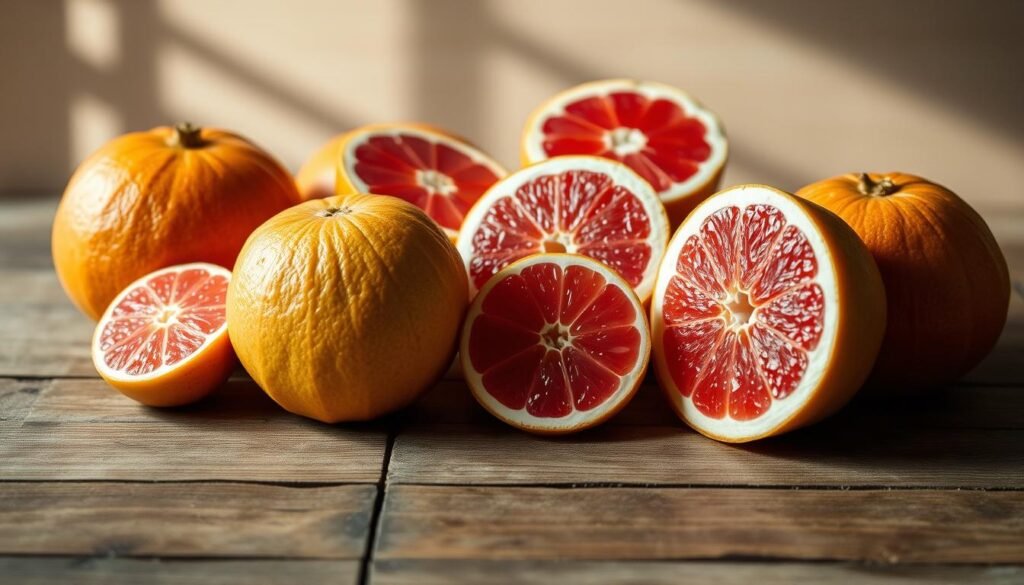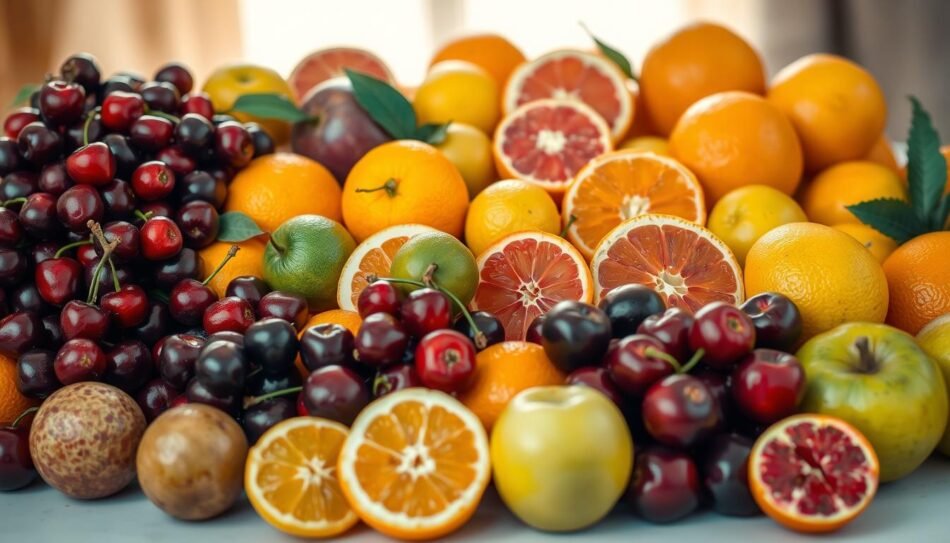Discover the vibrant world of Citrus & Tart Fruits and learn how to select, store, and enjoy these tangy delights. Your complete guide to nature’s zesty treasures.
Every summer, I remember the burst of sunshine from a perfectly ripe orange. It turns an ordinary moment into something magical. Citrus & tart fruits are not just food—they’re an experience that awakens your senses and connects you to nature’s most vibrant flavors.
When you peel an orange, you release its aromatic essence. This fruit is packed with incredible nutrition and zesty character. These fruits are nutritional powerhouses, offering more than just delightful taste. They bring vitamin C, essential minerals, and a refreshing complexity that can brighten any meal or beverage.
In this guide, you’ll discover the incredible world of citrus and tart fruits. We’ll explore their unique characteristics, health benefits, and culinary potential. Whether you’re a food enthusiast or simply looking to enhance your diet, these fruits promise an exciting journey of flavor and wellness.
Key Takeaways
- Citrus fruits are rich in essential nutrients
- Each fruit offers unique flavor profiles
- Oranges provide exceptional nutritional value
- Tart fruits can enhance both sweet and savory dishes
- Understanding fruit selection improves culinary experiences
Understanding the World of Citrus
Citrus fruits are like nature’s colorful treasures. They burst with flavor and are full of nutrients. From tangy lemons to zesty limes, they mix great taste with health benefits.
Citrus fruits are special for many reasons. They are loved by food lovers and health fans alike. Their unique traits make them stand out.
What Makes Citrus Fruits Unique
Citrus fruits are known for their amazing qualities:
- They are full of vitamin C
- They have vibrant, aromatic oils
- They taste from sweet to tart
- They have bright, colorful skins
Health Benefits and Nutritional Value
Lemons and limes are full of nutrients. They can boost your immune system and help your overall health. They are packed with:
| Nutrient | Benefits | Quantity per Fruit |
|---|---|---|
| Vitamin C | Immune Support | 30-40% Daily Value |
| Antioxidants | Reduce Inflammation | High Concentration |
| Flavonoids | Heart Health | Significant Levels |
« Citrus fruits are like nature’s multivitamin, packed with essential nutrients in a delicious package. » – Nutrition Expert
Seasonal Availability and Selection
When picking lemons and limes, look for:
- Firm fruits with a slight give
- Bright, vibrant color
- Smooth skin without soft spots or blemishes
- Heavy fruits, meaning they are juicy
Pro tip: Winter and early spring are the best times for citrus fruits. They taste and are most nutritious then.
Oranges: The Sweet Stars of Citrus
Oranges are the top citrus fruits, known for their sweet taste and health benefits. They come in many varieties, making your meals and snacks better. Oranges add great flavor and are very versatile.
Let’s explore the most popular orange varieties:
- Navel Oranges: Known for their thick, easy-to-peel skin and naturally sweet taste
- Valencia Oranges: Perfect for juicing with a bright, refreshing flavor
- Blood Oranges: Distinctive deep red interior with a unique, slightly tart profile
When picking oranges, choose ones that feel heavy and have smooth skin. Ripe oranges will give a bit when you squeeze them. You can eat them fresh, in salads, or in desserts.
Oranges are also very nutritious. They’re full of vitamin C, which boosts your immune system. They also have antioxidants that protect your cells. Tangerines, related to oranges, are smaller but sweeter.
Pro tip: Store oranges at room temperature for up to a week, or refrigerate to extend their freshness for up to two weeks.
Lemons and Their Varieties
Lemons are vibrant citrus fruits that add a burst of tangy flavor to kitchens everywhere. They are more than just a simple ingredient. They are a culinary powerhouse, full of versatility and nutrition.
Exploring the world of lemons reveals a wide range of types. Each type has unique characteristics and flavors. Knowing these varieties helps you pick the perfect lemon for your recipes.
Common Lemon Types
- Eureka Lemons: The most common variety found in grocery stores
- Lisbon Lemons: Slightly more acidic with fewer seeds
- Verna Lemons: Popular in Mediterranean cuisine
- Interdonato Lemons: Mild and less tart
Meyer Lemons: A Special Hybrid
Meyer lemons are a unique citrus hybrid. They are believed to be a cross between traditional lemons and mandarin oranges. These lemons have a sweeter, less acidic taste. Their smooth, thin skin and deep yellow-orange color make them a favorite among chefs and home cooks.
Culinary Applications and Uses
Lemons are incredibly versatile in the kitchen. You can use them to:
- Enhance seafood and poultry dishes
- Create zesty marinades and dressings
- Bake delicious desserts like lemon bars and tarts
- Preserve foods through pickling
- Add brightness to salads and cocktails
Whether you’re making a grapefruit salad or squeezing fresh lemon juice, these citrus fruits add unparalleled flavor and nutritional benefits to your meals.
Exploring the World of Limes
Limes are vibrant citrus fruits that add zesty flavor to dishes worldwide. These small, green fruits are packed with tangy goodness. They can change any dish or drink. From Mexican to Southeast Asian cooking, limes are key to memorable meals.
When exploring limes, you’ll find several exciting varieties:
- Persian limes: The most common type found in grocery stores
- Key limes: Smaller and more aromatic, perfect for key lime pie
- Kaffir limes: Prized in Thai and Southeast Asian cuisine
- Calamansi: A unique Filipino citrus with intense flavor
Each lime variety has unique traits that can enhance your cooking. The calamansi, for example, offers a special mix of sweet and sour flavors. Chefs adore it.
| Lime Variety | Flavor Profile | Culinary Uses |
|---|---|---|
| Persian Lime | Bright, acidic | Marinades, cocktails, seafood |
| Key Lime | Intense, slightly bitter | Desserts, pies, key lime pie |
| Calamansi | Sweet-sour | Sauces, drinks, Filipino cuisine |
Limes are full of vitamin C and antioxidants. They boost your immune system, help with digestion, and add a refreshing twist to meals. When picking limes, choose fruits that feel heavy and have smooth, vibrant skin.
Pro tip: Roll limes on the counter before juicing to maximize their juice extraction!
Citrus & Tart Fruits: Essential Storage Tips
Keeping your citrus and tart fruits fresh needs special care. Whether you’ve picked up juicy pomelos or tangy lemons, knowing how to store them is key. This helps keep their flavor and nutrients at their best.
Storing citrus fruits right can make them last longer and taste better. Each type of citrus needs a bit different care to stay fresh.
Proper Storage Methods
- Room temperature storage is best for citrus fruits you’ll eat in a week
- Keep them in a cool, dry spot, away from sunlight
- Don’t store near fruits that ripen fast, as they release ethylene gas
- Use breathable bags to keep air moving
Extending Shelf Life
Refrigeration can make your citrus fruits last longer. For pomelos and other thick-skinned citrus, you can store them in the crisper for up to two weeks.
- Wash fruits before storing
- Pat them dry to avoid moisture
- Store in bags with holes
- Check often for signs of spoilage
Signs of Freshness and Ripeness
Finding the perfect citrus fruit means checking a few things. Look for fruits that are heavy, have smooth, bright skin, and smell sweet. Stay away from fruits with soft spots, mold, or big blemishes.
Pro tip: Gently press the fruit – it should have a slight give without feeling mushy.
Grapefruit Varieties and Uses

Explore the world of grapefruits, a citrus fruit that adds a unique mix of tartness and sweetness. These juicy fruits come in several delightful varieties. They can make your meals more exciting and boost your nutrition.
Grapefruit varieties offer different flavors and colors, making them versatile in the kitchen. The most popular types include:
- Ruby Red: Known for its deep pink-red flesh and sweet taste
- Pink: A milder version with lighter coloration
- White: The classic grapefruit with a more pronounced bitter note
Grapefruits are also packed with nutrients. They are rich in vitamin C, antioxidants, and offer benefits for weight management and heart health. A half grapefruit contains just 52 calories, making it a great diet addition.
| Grapefruit Variety | Flavor Profile | Peak Season |
|---|---|---|
| Ruby Red | Sweet and mild | Winter |
| Pink | Balanced sweetness | Late fall to early spring |
| White | Tart and slightly bitter | Winter months |
Try adding grapefruit to salads, cocktails, or enjoy it fresh for a zesty burst of flavor. Pair it with kumquats for an exciting citrus combination that will elevate your culinary experience.
Exotic Citrus Discoveries
Explore unique and extraordinary citrus fruits beyond oranges and lemons. These rare gems offer extraordinary flavors and culinary experiences. They will change how you see citrus.
Buddha’s Hand Citron: A Fragrant Botanical Curiosity
The Buddha’s Hand citron is a remarkable citrus variety. It has finger-like segments and lacks pulp and juice. Its fragrant rind is highly valued by chefs and home cooks for:
- Zesting in baked goods
- Infusing spirits and oils
- Creating aromatic garnishes
- Decorative culinary presentations
Yuzu: Japan’s Culinary Treasure
Yuzu comes from China but is key in Japanese and Korean cuisine. This small, bumpy citrus fruit has a strong, complex flavor. It’s a mix of lemon, mandarin, and grapefruit. Chefs love yuzu for its unique taste in:
- Ponzu sauce
- Marinades
- Cocktail preparations
- Specialty desserts
Kumquats: The Edible Whole Citrus Wonder
Kumquats are a unique twist on traditional citrus fruits. You can eat them entirely – rind and all. Their sweet-tart flavor makes them great for both sweet and savory dishes.
| Fruit | Origin | Unique Characteristic |
|---|---|---|
| Yuzu | East Asia | Intense, complex citrus flavor |
| Kumquats | Southeast Asia | Entirely edible with sweet-tart taste |
| Buddha’s Hand | China | Fragrant rind, no pulp or juice |
Trying these exotic citrus fruits will open up new culinary possibilities. They offer flavors that go beyond what you might expect from citrus.
Essential Tools for Citrus Preparation

Preparing citrus & tart fruits like oranges needs the right tools. Whether you’re cooking at home or in a professional kitchen, the right equipment makes a big difference. It brings out the best in these vibrant fruits.
Your citrus preparation toolkit should include several key items:
- Citrus Juicers: Choose between manual and electric models depending on your needs
- Microplane Zester: Perfect for extracting delicate citrus zest
- Citrus Peeler: Makes removing skin quick and easy
- Fruit Segmenter: Helps create clean, precise citrus segments
When picking a juicer for oranges and other citrus fruits, think about these things:
- Ease of use
- Juice extraction efficiency
- Cleaning convenience
- Durability of materials
« A good citrus tool is like a painter’s brush – it helps you create culinary art with precision and ease. »
Professional chefs say investing in quality tools is key. A sharp microplane zester is essential. It captures the essential oils and bright flavors that make these fruits special.
Tangerines and Mandarins
Tangerines and mandarins burst with sweet, vibrant flavor. They are small, easy to peel, and perfect for snacking. They add a delightful zest to many dishes.
Common Varieties to Explore
Discover the world of these tasty fruits with some popular types:
- Clementines: Known for their seedless nature and sweet taste
- Satsuma mandarins: Incredibly soft and mild in flavor
- Tangelos: A unique hybrid with a tangy-sweet profile
- Dancy tangerines: Bright orange with an intense citrus flavor
Seasonal Availability Insights
Tangerines and pomelos are at their best in winter. From November to March, they are the most flavorful and juicy in stores and markets.
Culinary and Nutritional Highlights
These citrus fruits are more than a tasty snack. Tangerines are packed with vitamin C and are very versatile in cooking:
- Fresh salad garnishes
- Refreshing juice blends
- Zesty marinades for chicken or fish
- Vibrant dessert toppings
Pro tip: Choose tangerines that feel heavy for their size and have smooth, bright skin for the best flavor and juiciness.
Looking for a quick snack or a bright ingredient for cooking? Tangerines and mandarins are a perfect mix of sweetness and nutrition.
The Art of Citrus Zesting and Juicing
Learning to zest and juice lemons and limes can change how you cook. These fruits add a burst of flavor and health benefits to any dish. They’re perfect for both sweet and savory recipes.
Zesting needs precision and the right tools. Here are some important steps:
- Use a microplane for fine, delicate zest
- Avoid the bitter white pith underneath the colored skin
- Rotate the fruit while zesting to get maximum flavor
For juicing, different methods can help get the most juice:
- Roll the fruit on the counter to break down internal membranes
- Cut the fruit at room temperature for better juice yield
- Use a citrus reamer or electric juicer for efficient extraction
Pro tip: Citrus peels have more vitamin C and fiber than the fruit itself. Don’t throw them away – use zest in marinades, baking, or garnishes to add nutrition.
Fresh zest and juice can elevate any recipe from ordinary to extraordinary!
Creative cooks know lemons and limes are versatile. They’re great for tangy salad dressings, refreshing cocktails, or zesty desserts. These citrus fruits add vibrant flavor to your dishes.
Conclusion
Your journey into citrus & tart fruits opens up a world of flavors. You’ll find everything from oranges and lemons to exotic calamansi. These fruits can change how you cook and eat.
Every fruit has its own special qualities. You can use them for juice, zest, or eating raw. They make simple dishes better and add important nutrients.
The citrus world is full of possibilities. Try fruits like calamansi, kumquats, or yuzu for new tastes. Your meals will get brighter, healthier, and more exciting.
Don’t miss out on the zesty fun of these fruits. Add more citrus & tart fruits to your meals. Your cooking will become more vibrant and nutritious. Your culinary journey is just starting!









